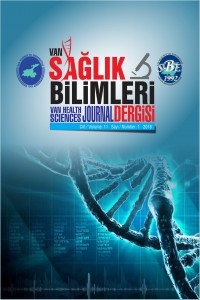Farklı Özofagogastrik Anastomoz Tekniklerinin Basınç Dirençlerinin Karşılaştırılması: Bir Ex Vivo Küçükbaş Hayvan Modeli Çalışması
esophagogastric anastomosis, stricture, surgical techniques, esophagus, stomach
Comparison of Pressure Resistances of Different Esophagogastric Anastomosis Techniques: An Ex Vivo Ovine Model Study
Esophagogastric Anastomosis, Stricture, Surgical Techniques, Esophagus, Stomach,
___
- 1) Bradshaw CJ, Sloan K, Morandi A, Lakshminarayanan B, Cox SG, Millar AJ, Lakhoo K. Outcomes of Esophageal Replacement: Gastric Pull-Up and Colonic Interposition Procedures. Eur J Pediatr Surg 2018;28:22-29.
- 2) Bolca C, Dumitrescu M, Fotache G, Stoica R, Cadar G, Cordoș I. Comparative Study of Early Postoperative Complications: Thoracic Anastomosis vs Cervical Anastomosis–in Esophageal Replacement with Gastric Graft. Chirurgia (Bucur) 2018;113: 95-100.
- 3) Shuangba H, Jingwu S, Yinfeng W, Yanming H, Qiuping L, Xianguang L, Zhenkun Y. Complication following gastric pull-up reconstruction for advanced hypopharyngeal or cervical esophageal carcinoma: a 20-year review in a Chinese institute. Am J Otolaryngol 2011;32:275-278.
- 4) Briel JW, Tamhankar AP, Hagen JA, DeMeester SR, Johansson J, Choustoulakis E, DeMeester TR. Prevalence and risk factors for ischemia, leak, and stricture of esophageal anastomosis: gastric pull-up versus colon interposition. J Am Coll Surg 2004;198:536-541.
- 5) Melek M, Cobanoglu U. A new technique in primary repair of congenital esophageal atresia preventing anastomotic stricture formation and describing the opening condition of blind pouch: plus (‘‘+’') incision. Gastroenterol Res Pract 2011;2011:527323.
- 6) Sharma AK, Wakhlu A. Simple technique for proximal pouch mobilization and circular myotomy in cases of esophageal atresia with tracheoesophageal fistula. J Pediatr Surg 1980;29:1402-1403.
- 7) Singh SJ, Shun A. A new technique of anastomosis to avoid stricture formation in oesophageal atresia. Pediatr Surg Int 2001;17:575-577.
- 8) El-Malt M, Ceelen W, van den Broecke C, Cuvelier C, Van Belle S, De Neve W, de Hemptinne B, Pattyn P. Healing of experimental colonic anastomoses effects of combined preoperative high-dose radiotherapy and intraperitoneal 5-flourouracil. Int J Cancer 2001;96:297–304.
- 9) Raman V, Moodie KL, Ofoche OO, Kaiser LR, Erkmen CP. Endoscopy after esophagectomy: Safety demonstrated in a porcine model. J Thorac Cardiovasc Surg 2017;154(3):1152-1158.
- 10) Whooley BP, Law S, Murthy SC, Alexandrou A, Wong J. Analysis of reduced death and complication rates after esophageal resection. Ann Surg 2001;233:338-344.
- 11) Verstegen MH, Bouwense SA, van Workum F, ten Broek R, Siersema PD, Rovers M, Rosman C. Management of intrathoracic and cervical anastomotic leakage after esophagectomy for esophageal cancer: a systematic review. World J Emerg Surg 2019;14:17.
- 12) Koruda MJ, Rolandelli RH. Experimental studies on the healing of colonic anastomoses. J Surg Res 1990;48:504-515. 13) Hendriks T, Mastboom WJB. Healing of experimental intestinal anastomoses. Parameters for repair. Dis Colon Rectum 1990;33:891-901.
- 14) Levi A, Ramadan E, Gelber E, Koren R, Chaimo C, Kyzer S. Healing of the esophageal suture line: does it differ from the rest of the alimentary tract? Isr J Med Sci 1996;32:1313-1316.
- 15) Urschel JD, Takita H, Antkowiak JG. The effect of ischemic conditioning on gastric wound healing in the rat: implications for esophageal replacement with stomach. J Cardiovasc Surg 1997;38:535-538.
- 16) Hsu HK, Hsu WH, Huang MH. Prospective study of using fibrin glue to prevent leak from esophagogastric anastomosis. J Surg Assoc ROC 1992;25:1248-1252.
- 17) Spitz L. Oesophageal atresia. Orphanet J Rare Dis 2007;2:24.
- 18) Cui Y, Urschel JD. Comparison of anastomotic suturing techniques in the rat esophagus. J Cardiovasc Surg 1999;40:613-614.
- 19) Chunwei F, Qingzeng N, Jianliang L. Cervical esophagogastric anastomosis with a new stapler in the surgery of esophageal carcinoma. Eur J Cardiothorac Surg 2005;28:291-295.
- 20) Peracchia A, Bardini R, Ruol A. Esophagovisceral anastomotic leak: a prospective statistical study of predisposing factors. J Thorac Cardiovasc Surg 1988;95:685-691.
- 21) Law S, Fok M, Chu KM, Wong J. Comparison of hand-sewn and stapled esophagogastric anastomosis after esophageal resection for cancer: a prospective randomized controlled trial. Ann Surg 1997;226:169-173.
- 22) Ein S, Ashcraft KW. Discussion: long-term results following repair of esophageal atresia by end-to-side anastomosis and ligation of the tracheoesophageal fistula. J Pediatr Surg 1981;16:983-988.
- 23) Gough MH. Esophageal atresia: use of an anterior flap in the difficult anastomosis. J Pediatr Surg 1980;15:310-311.
- 24) Sulamaa M, Gripenberg I, Alvenainen EK. Prognosis and treatment of congenital atresia of the oesophagus. Acta Chirurgica Scandinavia 1951;102:141-157.
- 25) de Carvalho JL, Maynard J, Hadley GP. An improved technique for in situ esophageal myotomy and proximal pouch mobilization in patients with esophageal atresia. J Pediatr Surg 1989;24:872-873.
- 26) Lindahl H. Esophageal atresia: A simple technical detail aiding the mobilization and circular myotomy of the proximal segment. J Pediatr Surg 1987;22:113-114.
- 27) Aumar M, Rousseau V, Bonnard A, Sfeir R, Gelas T, Boubnova J, Lamireau T. DOZ047.01: Risk factors for anastomotic strictures in the first year after esophageal atresia repair: data from a prospective multicentric cohort. 2019, https://doi.org/10.1093/dote/doz047.01.
- 28) Yurtçu M, Findik S, Yurtçu ME, Baba ZF. Investigation of Histopathologic Changes in Pelviureteral Anastomoses after Local Application of Fibrinogen and Thrombin. SOA Clin Med Cases Rep Rev 2018;4:2.
- ISSN: 2667-5072
- Başlangıç: 2018
- Yayıncı: Van Yüzüncü Yıl Üniversitesi
Birinci Basamak Sağlık Kuruluşuna Başvuran Yetişkinlerin Diyabet Risk Skorları: Kesitsel Bir Çalışma
Hasan EVCİMEN, Neşe İŞCAN AYYILDIZ, Ufuk DOĞAN
Oral Kapiller Hemanjiyom Tanısı ve Tedavisi: Olgu Sunumu
Mert AKBAŞ, Emre HAYLAZ, Zülfikar KARABIYIK, Gediz GEDUK
Yetişkin Diyabetik Hastalarda HbA1c ve 25-hidroksi D Vitamini Düzeyleri Arasındaki İlişki
Yalçın DİCLE, Elif AYDIN, Duygu Kübra TUNA
Duygu MERGAN İLİKLERDEN, Ümit Haluk İLİKLERDEN, Ozan OKYAY, İbrahim ÖZALP, Orhan BEGER, Serhat BİNİCİ, Burhan BEGER, Caner KAYIKCI
Aşırı Aktif Mesaneli Kadınlarda Depresyon İlişkisi
Süleyman SAĞIR, Kübra SEZER KATAR, Müslüm ERGÜN, Mustafa KURTOĞLU
Hesna URAL ULUCAN, Didem YILMAZ, Fulya ÖZDEMİR, Elif Burcu ACAR, Erkan KEÇECİ
Erhan ERKAN, Keziban OLCAY, Tan Fırat EYÜBOĞLU, Elif ŞENER, Mustafa GÜNDOĞAR
Epistaksisle Başvuran Geriyatrik Hastaların Analizi
Servet ERDEMES, Ahmet YÜKKALDIRAN, Osman ERDOĞAN, Müslüm AYRAL
